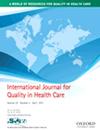对用于验证行政数据中不良事件发生率的回顾性病历审查方法进行范围界定审查
IF 2.7
4区 医学
Q2 HEALTH CARE SCIENCES & SERVICES
引用次数: 0
摘要
背景 患者安全是医疗系统的关键质量问题。医疗不良事件(AEs)会影响医疗安全和质量;因此,报告和监测不良事件是患者安全的当务之急。尽管行政数据集是监测不良事件发生率的潜在有效工具,但其数据的准确性仍令人担忧。需要进行病历回顾验证研究,以探索行政数据为研究和卫生政策提供信息的潜力。本综述旨在概述通过病历审查验证行政数据中不良事件发生率的方法和策略。方法 本综述按照乔安娜-布里格斯研究所(Joanna Briggs Institute)的范围界定综述方法框架进行。通过数据库搜索,确定了 1054 个资料来源,将其导入 Covidence,并根据纳入标准进行筛选。通过病历审查验证行政数据中AEs发生率的文章被纳入其中。提取数据并导出至 Microsoft Excel,将其排列成图表,并以表格和描述性格式呈现。结果 共纳入 56 项研究。大多数资料来源报告的是外科不良事件,但也探讨了其他医学专科的不良事件。所有研究都使用了病历回顾,但很少有研究就研究设计的术语达成一致。研究采用了多种方法和抽样策略。一些研究使用了全球触发工具(一种两阶段病历审查方法),而其他研究则使用了其他单阶段、两阶段或不明确的方法。资料来源使用的样本包括标记图表(n=24)、标记和随机图表(n=11)以及随机图表(n=21)。大多数研究报告不良事件发生率的准确性较差或中等。一些研究报告不良事件记录的准确性较好,这凸显了将管理数据用于研究目的的潜力。结论 本综述强调了管理数据在提供不良事件发生率信息、改善患者安全和医疗质量方面的潜力。然而,要确保行政数据的准确性,还需要进一步的努力。所采用的方法和抽样技术各不相同,这表明在最佳实践方面缺乏共识,因此有必要进一步明确和达成共识,以制定更系统的图表审查方法。本文章由计算机程序翻译,如有差异,请以英文原文为准。
A scoping review of the methodological approaches used in retrospective chart reviews to validate adverse event rates in administrative data
Background Patient safety is a key quality issue for health systems. Healthcare acquired adverse events (AEs) compromise safety and quality; therefore, their reporting and monitoring is a patient safety priority. Although administrative datasets are potentially efficient tools for monitoring rates of adverse events, concerns remain over the accuracy of their data. Chart review validation studies are required to explore the potential of administrative data to inform research and health policy. This review aims to present an overview of the methodological approaches and strategies used to validate rates of adverse events in administrative data through chart review. Methodology This review was conducted in line with the Joanna Briggs Institute methodological framework for scoping reviews. Through database searches, 1054 sources were identified, imported into Covidence, and screened against the inclusion criteria. Articles that validated rates of AEs in administrative data through chart review were included. Data were extracted, exported to Microsoft Excel, arranged into a charting table, and presented in a tabular and descriptive format. Results Fifty-six studies were included. Most sources reported on surgical adverse events however, other medical specialties were also explored. Chart reviews were used in all studies, however few agreed on terminology for the study design. Various methodological approaches and sampling strategies were used. Some studies used the Global Trigger Tool, a two-stage chart review method, whilst others used alternative single-, two-stage or unclear approaches. The sources used samples of flagged charts (n=24), flagged and random charts (n=11) and random charts (n=21). Most studies reported poor or moderate accuracy of adverse event rates. Some studies reported good accuracy of adverse event recording which highlights the potential of using administrative data for research purposes. Conclusions This review highlights the potential for administrative data to provide information on adverse event rates and improve patient safety and healthcare quality. Nonetheless, further work is warranted to ensure that administrative data are accurate. The variation of methodological approaches taken, and sampling techniques used demonstrate a lack of consensus on best practice, therefore, further clarity and consensus are necessary to develop a more systematic approach to chart reviewing.
求助全文
通过发布文献求助,成功后即可免费获取论文全文。
去求助
来源期刊
CiteScore
4.90
自引率
3.80%
发文量
87
审稿时长
6-12 weeks
期刊介绍:
The International Journal for Quality in Health Care makes activities and research related to quality and safety in health care available to a worldwide readership. The Journal publishes papers in all disciplines related to the quality and safety of health care, including health services research, health care evaluation, technology assessment, health economics, utilization review, cost containment, and nursing care research, as well as clinical research related to quality of care.
This peer-reviewed journal is truly interdisciplinary and includes contributions from representatives of all health professions such as doctors, nurses, quality assurance professionals, managers, politicians, social workers, and therapists, as well as researchers from health-related backgrounds.

 求助内容:
求助内容: 应助结果提醒方式:
应助结果提醒方式:


